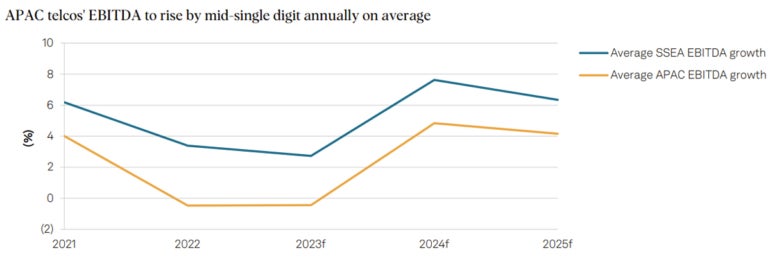Telstra Among APAC Telcos Seeking Innovation, Resilience and Growth in 2024

[ad_1]
Telecommunications companies in the Asia-Pacific region have entered 2024 facing cost pressures amid limited returns from their 5G investments to date. S&P Global Ratings forecasts that, while 5G adoption in many APAC markets remains too low to boost revenues, price rises such as labour and electricity are squeezing margins.
Cost pressures a prime driver for AI and product innovation

Telecommunications firm Telstra in Australia and other telcos across the region are responding with efforts to innovate and grow their revenue. According to Amazon Web Services’ Head of Telecommunications in Asia-Pacific and Japan Jayanth Nagarajan, key themes that will dominate agendas for regional telco executives in 2024 include:
- Leveraging data, generative AI and machine learning at scale.
- Building resilient, cost-effective and robust core networks.
- Growing business revenue through new products and services.
“Telcos are nationally mandated critical infrastructure in many countries, so deploying resilient and cost effective 5G networks is a given,” Nagarajan said. “But the corollary to that is cost pressures are real across the industry, and there’s a focus on looking for ways to build more resilient solutions while reducing total cost of ownership.” (Figure A)

AI top of mind for Asia-Pacific telecommunications companies
Artificial intelligence featured heavily at the Mobile World Congress 2024. While early use cases for telcos have focused on enhancing customer care and employee productivity, Nagarajan observes cost pressures mean telcos are now looking at AI as more than a search engine or chatbot, with use cases including network optimisation.
Customer service, employee productivity and networks are key use cases
A large number of telcos identified immediate use cases in the areas of customer service and employee productivity. Just some of those, according to AWS, have included forecasting the future needs of customers, suggesting retention offers and personalising customer recommendations to create a connected customer journey.
“We are also seeing a lot of employee productivity use cases like automating RFP responses and providing training and support,” Nagarajan explained, including giving engineers access to enterprise knowledge bases while in the field.
However Nagarajan said telcos are now also increasingly using AI to help optimise and automate networks, including smart planning, deployment and troubleshooting of their networks.
SEE: How telcos in Australia and New Zealand are embracing use cases for AI.
“We are starting to see the use of AI used in areas like the radio network and the SMO layer to drive finer grained control over radio towers and how they radiate,” said Nagarajan. “This makes them far more energy efficient. Telcos are extremely energy hungry, so any reduction to energy utilization is something they can take back to the CFO and the business.”
Telstra sees AI becoming an integrated part of network software
Leading Australian telco Telstra has been using AI “for a heck of a long time,” according to Telstra’s Network Technology Development & Innovation Executive Channa Seneviratne. Telstra’s CEO Vicki Brady recently revealed that AI was already being used to improve half of the telco’s key processes. This included automatic detection and resolution of fixed service faults, in addition to solving customer issues faster.
Seneviratne said that, while the deployment of AI was important from a customer service point of view, it would also be increasingly important for networks.
“What you’ll see as we go to 5G, to 5G-Advanced and then 6G is that AI will be more embedded in the network platform,” Seneviratne said. “So offline AI is there, but what you will see in the future is more integration of AI and machine learning models into software.”
Telcos building resilient, cost effective and robust core networks
The resilience and cost effectiveness of telecommunications core networks has become critical. For example, Telstra is using AI in its effort to make its network more automated, efficient, resilient and secure, but this means the need for GPUs is rising. Telstra’s Network Applications and Cloud Executive Shailin Sehgal said Telstra has needed to make enough room in its power budget for this to be efficient and sustainable.
SEE: IBM Consulting seeing evidence of innovation in Australia AI deployments.
In February 2024, Telstra announced a deployment of Ericsson’s bare metal cloud environment, also known as Cloud Native Infrastructure Solution, which can boost 5G core efficiency with high-density microprocessors from Advanced Micro Devices. With closed-loop liquid cooling, energy consumption is reduced by 49%, described as “a major technological leap” for its private cloud infrastructure.
Telecommunications firms making greater use of cloud services
Telecommunications companies have been escalating their use of the cloud to support network resilience and reduce cost, according to Nagarajan. AWS has witnessed more BSS and OSS applications moving at scale, as well as more network workloads. There was also an expansion in new use cases, including using the elasticity of the cloud for resilience enhancement and disaster recovery among telcos.
Landmark Telstra trial uses AWS to boost network resilience in a crisis
Telstra recently announced a hybrid network architecture resiliency trial that would ensure continuity of voice calls during unplanned network interruptions, where the primary solution is not working correctly. Using Nokia’s IP Multimedia Subsystem software in a collaboration with cloud provider AWS, Telstra said the trial showed the potential for on-demand capacity in an unplanned network disruption scenario.
“When deployed at scale this will provide enhanced network resiliency by allowing call control to be supported by the cloud, rather than experiencing a network disruption,” Telstra said in a statement.
Telstra is working with AWS and Nokia on expanding the trial beyond Voice over LTE on IMS, with hopes it could include the full scale of network provided services, including data services like Eftpos and text messaging.
Growing business revenue through new products and services
Telecommunications companies are looking for new ways to boost revenue.
“They’re looking to innovate quicker, and they’re looking to build in-house capabilities to develop and introduce new services for their customers,” Nagarajan explained. “But we all know the challenges that the industry is facing; legacy applications, traditional long-standing workforce development processes, being steeped in legacy regulatory environments.”
Monetising 5G a priority in the Asia-Pacific region
Much of the focus is on monetising investments in 5G networks.
“For the past few years I think we’ve heard the promise of added revenue from 5G, but we’ve yet to see that windfall which is the reality check,” Nagarajan commented.
Telstra, for one, has seen its 5G coverage increase to 87% of the Australian population as of the beginning of 2024, with 48% of mobile traffic now on 5G, though not all of this is stand-alone 5G.
Nagarajan argues 2023 could have marked a tipping point for 5G, with global and Asia Pacific 5G coverage growing, devices starting to catch up, and use cases for 5G technologies growing in sophistication.
“The last barrier to realising 5G potential is the community across industry and the cross-functional partnerships that are needed to create 5G services and to reduce the barriers to accelerating innovation,” Nagarajan said.
Telecommunications companies look to APIs to boost revenue
Nagarajan said one avenue for growth has been through operators exposing network capabilities through APIs. This is enabling telcos to leverage the developer community to bring services together from multiple parties to deliver an end customer outcome.
Telstra to offer 5G slicing product for enterprise customers
Telstra announced in February 2024 it would bring a 5G slicing product to market in 2024, which could offer guaranteed 5G performance to paying enterprise customers. Following the development of a new proof-of-value engine — which is able to analyse 5G traffic every second to check if a customer has received the committed performance — Telstra has said it will be able to create multiple virtual networks with different performance characteristics, so enterprises can access customised 5G solutions.
[ad_2]
Source Credit



